Curious about hunting dogs? Not sure what traits and breeding you should look for in a new waterfowl puppy? Are you having training put on your duck dog, and are keen to continue the dog’s—and your own—training once they come back home? Take your dog’s training to the next level in the nice summer months so you can tackle waterfowl season full-throttle.
We talked with three waterfowl dog experts around the country to learn what they look for in a working dog, how they approach training young dogs, and how someone ready to take on their own dog’s training regimen can avoid the most common pitfalls. Dog ownership is anything but easy, but these three gentlemen have found systems that help smooth the path.
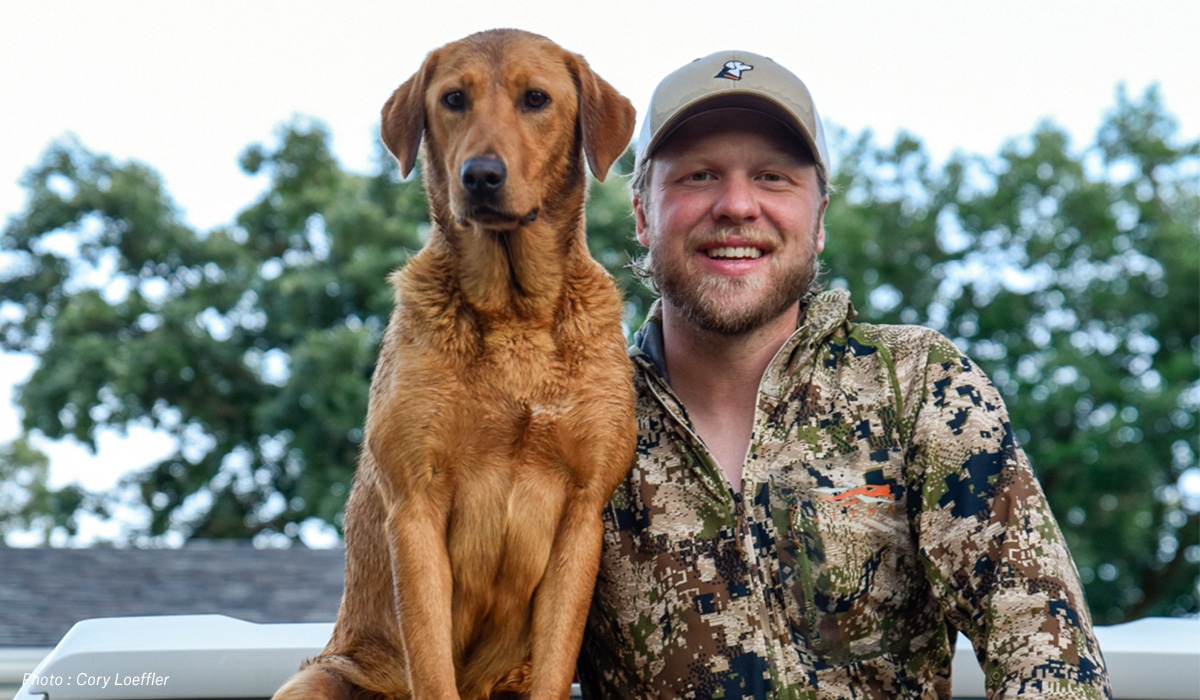
Meet the Experts
Born and raised in northern Minnesota, Cory Loeffler has been a full-time waterfowl call maker for the past 14 years. With his family and Labs, he hunts geese and ducks and focuses his dog training on producing well-rounded dogs that can go from field to family.
Bill Gibson is the Kennel Master at Mossy Oak Kennels in West Point, Mississippi. Specializing in breeding British Labrador Retrievers for hunting and outdoor companionship, Bill has a strong background in working dog tests in the United Kingdom and the Republic of Ireland. After a career as a federal agent, he moved back to his home turf of Mississippi and worked in law enforcement for several years before turning his focus wholly to the breeding and training of British Labradors.
Arkansas’s Mike Fortner focuses his business on Drahthaars. He grew up hunting around Pointers, Setters, Beagles, and Coonhounds, then became a “Lab guy.” When his search for a versatile dog to excel with waterfowl and upland birds led him to the Deutsch Drahthaar in 2004, he “never looked back.” He now owns Dilmunfast Drahthaars, focusing on producing dogs of character and confidence, ready to become part of the owner’s family.
Three different men, from different parts of the country. Yet it’s a combined love of hunting and dogs that unites them. A shared language that crosses regional lines.
The Paths to Duck Dog Ownership
For Bill Gibson, hunting with dogs is something he’s known since childhood. “I’ve been hunting all my life,” he notes. “Way back, I got started duck hunting and got interested in Labs. I had a job with the Department of Defense right out of college, so I couldn’t have a dog. But 27 years ago, after a career in federal and local law enforcement, I retired. And here I am today.”
Gibson bought his first British Lab nearly 20 years ago, and then a second. Soon he was connecting with new friends in the U.K. and Ireland, and in 2004, entered into working dog tests in Northern Ireland and the Republic of Ireland, and won two competitions: the Irish International and the Atlantic Cup. After a bustling career as a federal agent, he moved back home to Mississippi to work in law enforcement and soon found himself next-door neighbors with the CEO of Mossy Oak, who asked him to train his hunting dogs.
Sometimes the path is a bit more winding. Growing up in the Midwest, Cory Loeffler didn’t have exposure to quality hunting dogs in his early years.
“To have a good hunting or working dog is more common in the South,” Loeffler shares. “You’re more apt to find a hunting household with a really good dog in the South versus up here in the upper Midwest. I didn’t have a lot of interest in a good waterfowl dog when I started hunting, because I had never seen a good one. I didn’t know how good a good dog could be; I had no idea that world existed.”
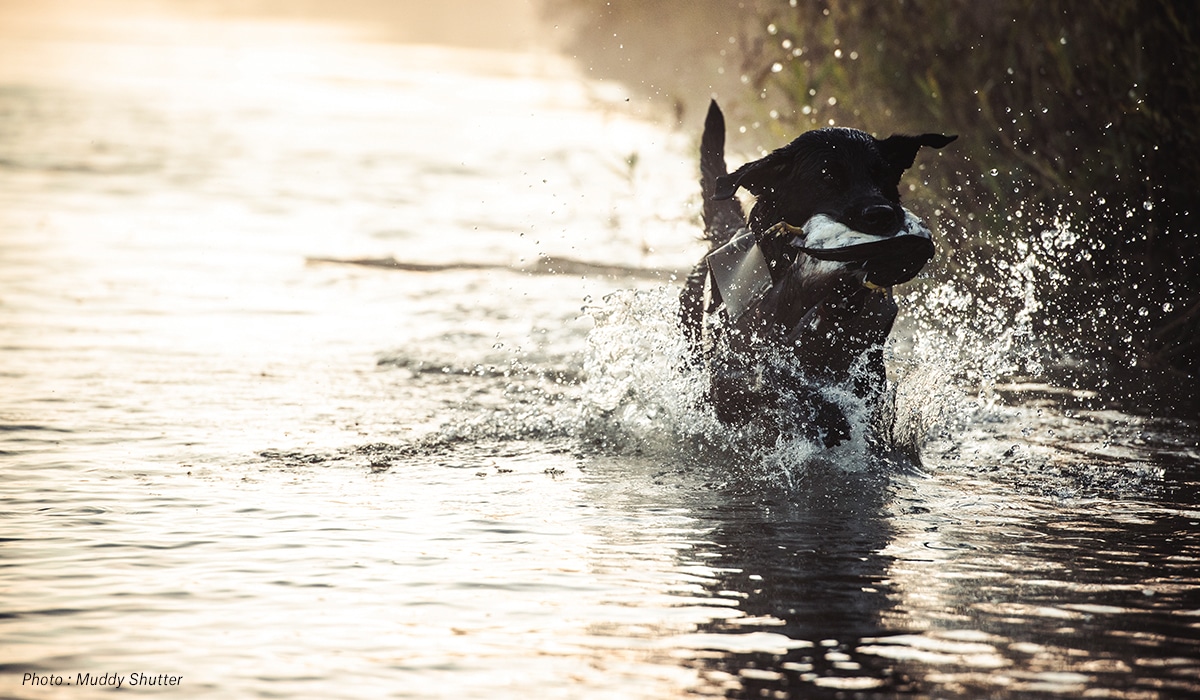
It was a friend’s dog—a well-trained black male Lab named Beau—who helped open the hunter’s eyes to the possibilities.
“I didn’t have a clue you could train a dog to be that good, that fast,” Loeffler admits. Nine years ago, Loeffler got his first chocolate Lab named Bella, and then Boone, soon turning eight, was his first hunting test dog. Exciting challenges were soon to follow.
Neither Boone nor Cory had been to an American Kennel Club (AKC) hunt test, and signed up for a Master test near Minneapolis.
“We trained like crazy,” he recalls. “Boone did all the right things at all the right times, while I pretty much screwed up everything I could.”
The judge took Boone’s effort into consideration and told Leoffler, “You’ve never been to a hunt test, have you?” Loeffler replied, “I realize that’s obvious; I’m just here to pay my dues and learn.” The judge’s answer was simple: “This isn’t a test for humans; this is a test for dogs. You need to go home and read the rulebook, but your dog did really well.”
“This isn’t a test for humans; this is a test for dogs. You need to go home and read the rulebook, but your dog did really well.”
The pair passed onto the second level of the three-level test series, and soon advanced to the third test. “Boone knocked that one out of the park, too,” Loeffler recalls. “We ended up passing the whole thing on our first try. We just dove in head-first; thought we’d go straight to the top and figure it out from there.” Eventually, Boone passed all six Master tests to get “Master Hunter” status with the AKC (considered an international dog registry, where owners or pro trainers can handle dogs at events).
Now Loeffler, his wife, and their three daughters breed and train Labrador retrievers, whelping about one litter a year and focusing on creating quality puppies ready to go to their new homes.
So, You’re Interested in a Duck Dog?
For Arkansas trainer and breeder Mike Fortner, one of the most important factors of dog ownership is finding compatibility and managing expectations.
“The number one thing I would tell someone interested in hunting with dogs is to find a breed that suits both your temperament and your intended uses,” Fortner notes. “If you are a super intense, Type-A person, you probably won’t do well with a Small Münsterländer; likewise, if you don’t have a strong personality, you have no business with a Drahthaar. Don’t pick a hunting dog breed just because it’s the new fad or you ‘just want something different.’ Remember that the duck dog you buy is going to be a pet for at least 300 days a year; you have to like him and he has to be someone you (and more importantly, your wife) can live with. Be realistic and be honest with yourself.”
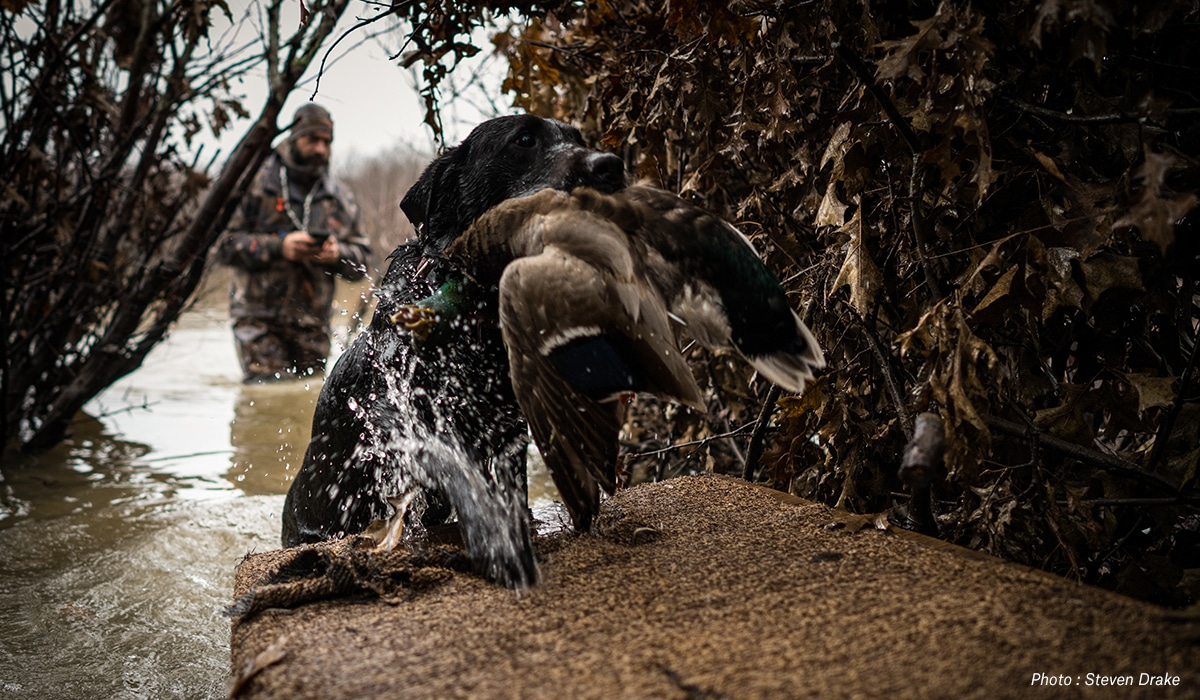
At Mossy Oak Kennels, Gibson views the basics through the lens of a seasoned kennel master, recommending prospective dog owners go to a fully tested Lab breeder with a good reputation.
“Look for a puppy that comes from a good line of hunting Labs,” he reminds. “In general, British Labs are raised differently; they’re bred for a different reason over there. In the U.K. they have more training opportunities than we do in real bird situations.” Knowing and understanding a dog’s lineage can help ensure you’ll come away with a puppy that’s suited for your intended purpose.
“You can’t build a nose in,” Gibson notes. “You’ve got to have a dog genetically capable of using that nose; a nose genetically built over generations to hunt. If you go buy a dog not genetically predisposed to retrieve, you can’t put predisposition in; the dog’s got to have that.”
On puppy pick day, Gibson looks for puppies with a “medium” tail position, believing that if the tail is carried too high, the pup will be too dominant. Tail carriage that’s too low can mark a submissive pup. He also looks for lip licking, noting that if he calls a puppy over and speaks kindly and it, if it then licks its lips, this means the dog is trainable. He likes it when a puppy comes up, then sits and stares—this is an indication that puppy likes him and the stare demonstrates focus at a young age.
Loeffler brings his own philosophy to duck dog selection and firmly believes in strong paperwork before he goes and sees a puppy. “Before I physically look at a puppy with my eyeballs, I’m going to need to see some other things fall into place first,” he notes. “Seeing the puppy and interacting with it is probably my least important criteria or category; as long as everything else checks out, I know with training everything else will fall into place.”
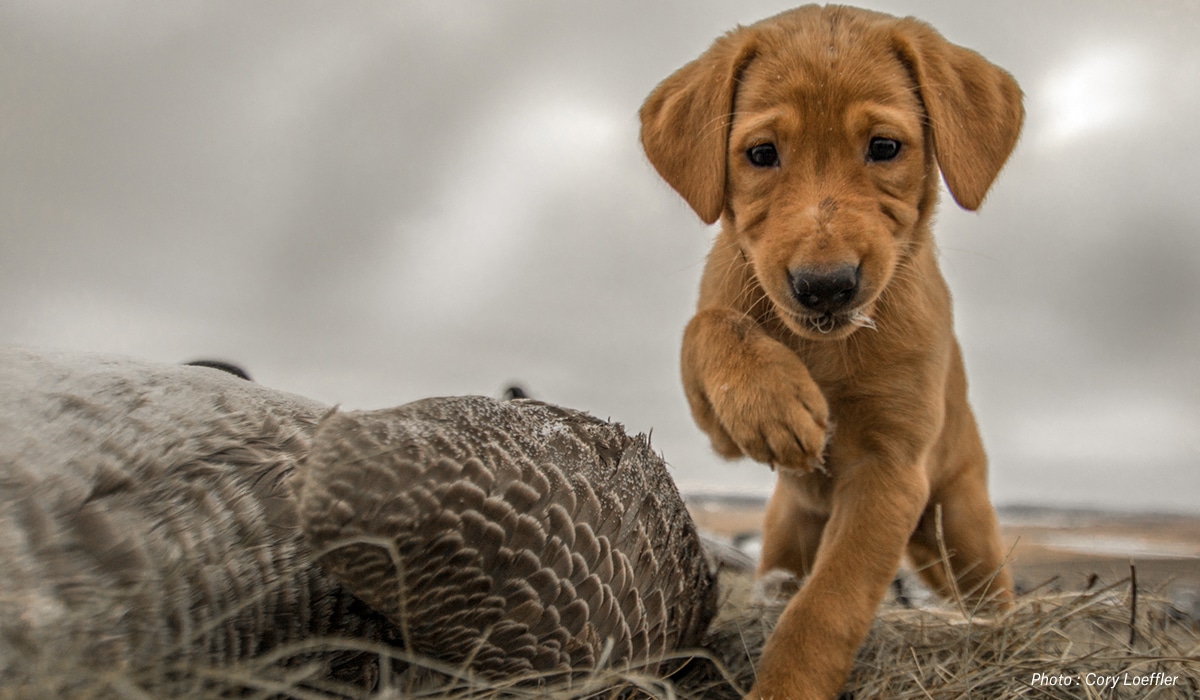
His criteria includes health tests (hips, elbows, eyes, and genetic testing), parentage and pedigree to see where puppies came from, and titles and health tests that ancestors have earned. He uses Hunting Lab Pedigree, a user-submission-based site, to search males, females, stud dogs, litters, and other user-submitted information. “It’s super helpful, interactive, and free,” he said.
He adds that picking a dog from a responsible breeder who’s not overwhelmed with the number of puppies on the ground at one time is key to a good start in life. He values health testing and genetic testing as critical factors for new dogs, noting, “[It’s] something we look for when we’re buying one and something we do very strongly with our breeding stock as well.”
You Have a Puppy… Now What?
Training Philosophy
Welcome to the arena. From the moment you meet your new dog, you’re laying the foundation for what will—with work, training, and strategy—be one of the most rewarding undertakings of your life.
It can be overwhelming. Somehow you’ve got to transform this squirming, sleeping eight-week-old puppy into an obedient, willing, and capable hunting partner. Where do you start?
Loeffler knows the importance of early-life training to a dog’s future success and happiness. Step one? He recommends looking up the Training a Retriever Puppy DVD and training program by Bill Hillmann, which starts with a seven-week-old puppy and runs through the next six months. Loeffler recommends the training system for anyone in the U.S. who owns a dog, noting the program is “… So much about dog behavior and dog psychology, how to bond, and good behaviors.”
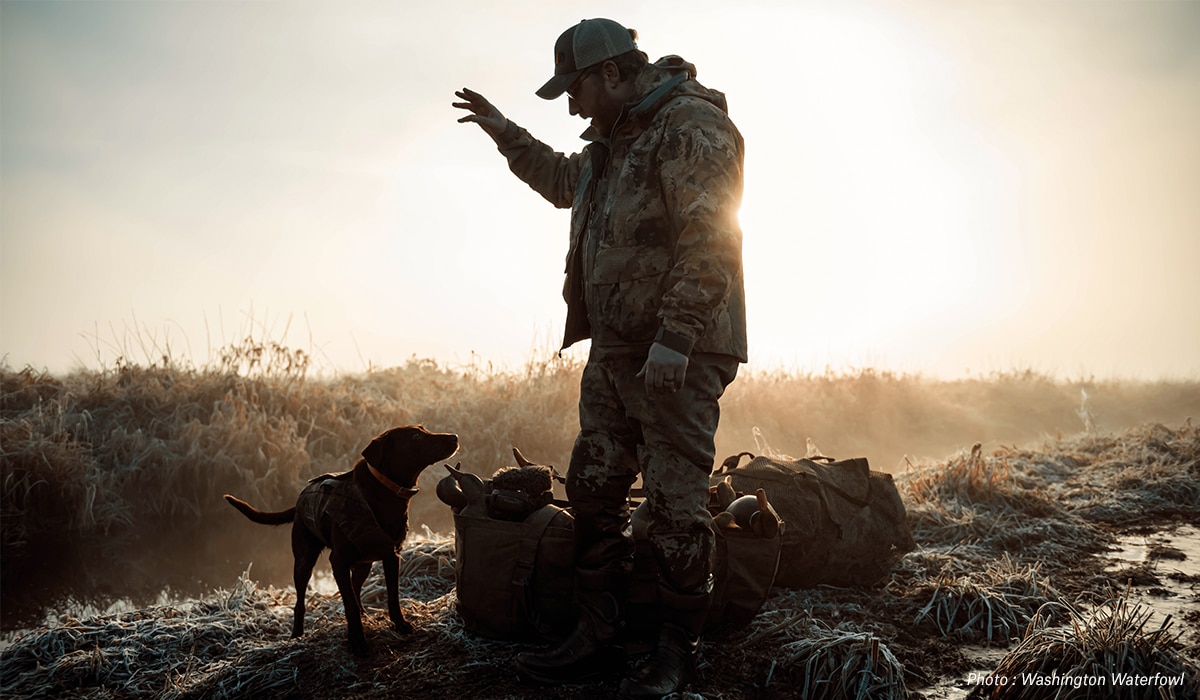
“If you follow that program to the letter—all his practices and everything he’s teaching and preaching—you’ll come out with an amazing six-month-old dog.” For Loeffler, the key to success is speaking the dog’s language in a way they’ll understand. “There are a lot of misconceptions about what people think dogs want versus what dogs actually want. Dogs are domesticated wolves, so they have a pack mentality. A good family/pack structure has very defined roles from the alpha male, to the alpha female, down to the subordinate—the kids, the up-and-comers. They know where they fit in, know what their job is. There’s no question about it.”
He adds that what humans think dogs want is, in fact, sometimes a skewed perception of that pack structure.
“They [owners] treat dogs like human babies, and that’s how you create a problem dog. The dog is now super confused; the owner is sometimes trying to discipline it, sometimes talking and treating it like a baby… the dog’s confused about its role. This makes the human weak in the dog’s eyes, so the dog then puts themselves above the human in hierarchy. The dog never knows where it fits in; it’s confused about identity and where it fits in. If you let the dog make decisions at home, who knows what that dog’s decision-making skills are going to be. We want humans making the decisions, not the dogs.”
“If you let the dog make decisions at home, who knows what that dog’s decision-making skills are going to be. We want humans making the decisions, not the dogs.”
In addition to Hillmann’s formula, Loeffler also recommends Tim and Lauren Springer’s Dynamic DIY Program for hunting dog owners wanting to train themselves alongside their dogs. The interactive training program provides users with a drill; the owner then videos themselves and their dog performing the drill and submits the video to the Springers for grading. Once the drill is marked with a passing grade, another drill is supplied via email.
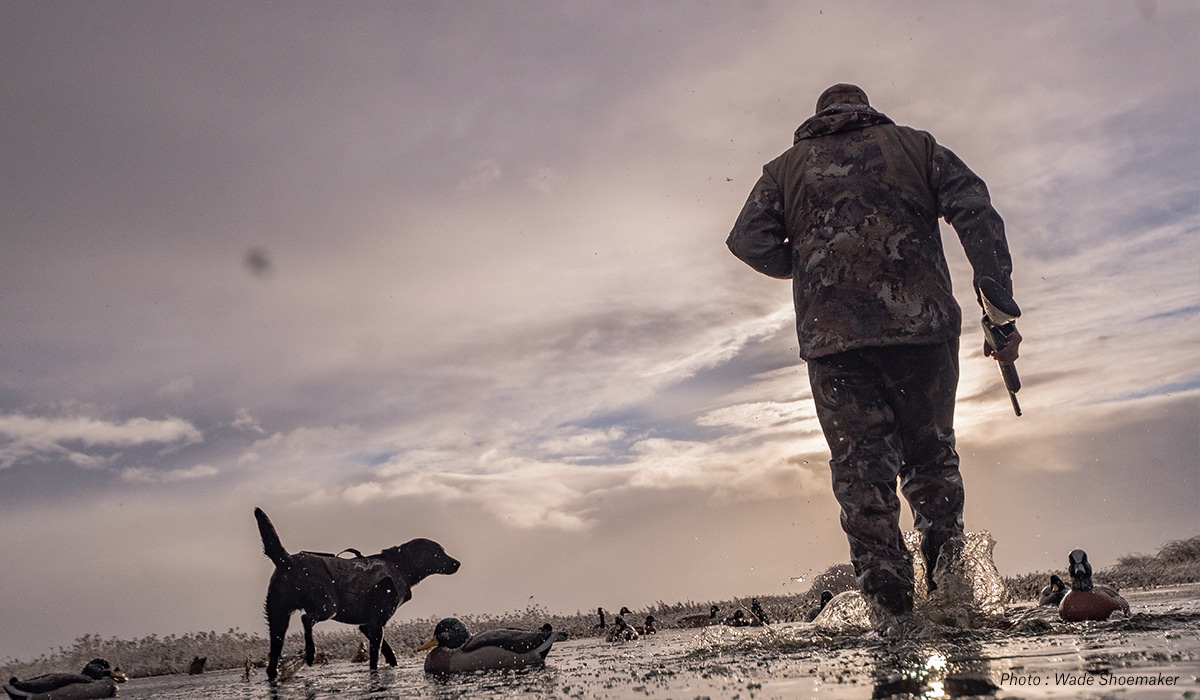
“If people want to level up; if they don’t want to send their dog off and want to train themselves, this is like a pro trainer in their pocket,” Loeffler informs. “Tim Springer is the smartest trainer I’ve ever run across, with an absolute wealth of knowledge.”
The Early Days
“By the time the dogs go to their new home, we feel very strongly we’ve produced a very good 7-week puppy,” Loeffler shares, explaining the dogs’ early days. “The puppies are on their own with mom for the first week, then in weeks two through six, we spend a ton of time with them. This time really sets those dogs off to the best start they could possibly get. When they go home they are ready to learn, love, and trust.” At seven weeks when a puppy departs the Loeffler household, the pup has had no training, but is ready to go home and start making forward progress; to hit the ground running.
“Early training—bonding, loving, forming that human-to-canine-bond—is number one, so the dog always trusts you,” Loeffler notes. “From there, you can get into whatever type of activity you’re going to do with your dog. The dog is ready for life, basically, at that point.”
Once a dog goes home at seven weeks, it’s time to go to work. Loeffler is a firm believer in treat training as a positive, effective method of training young hunting dogs.
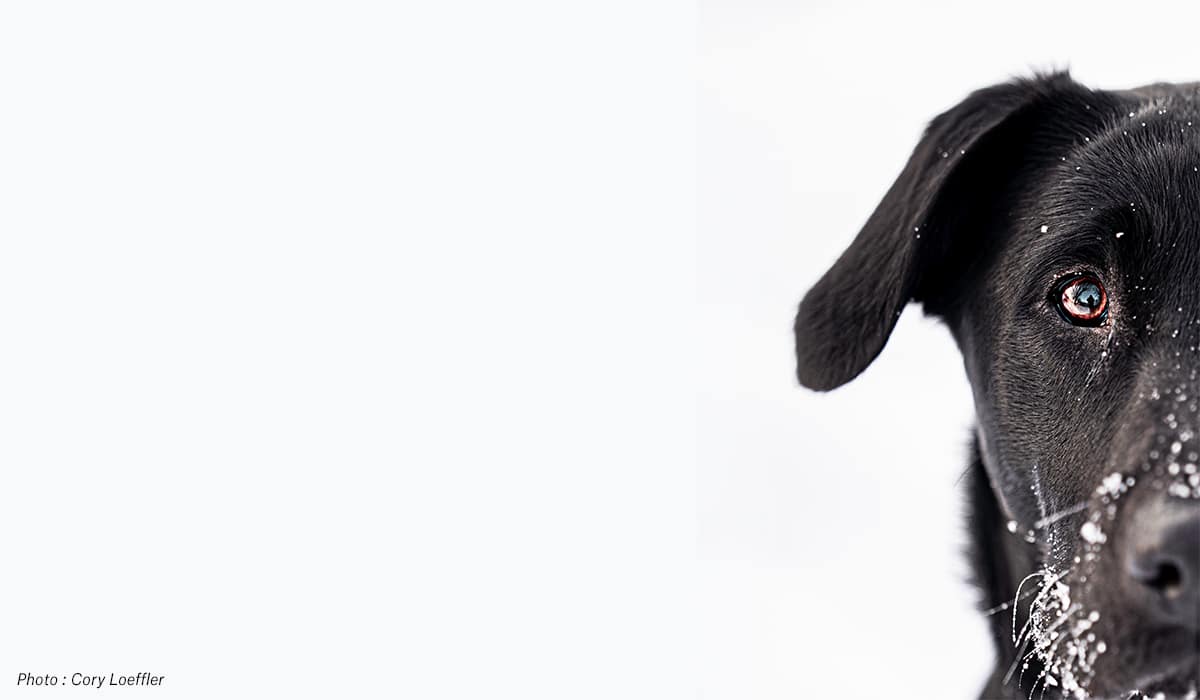
“Treat training at that very young age is extremely effective because you have something that the dog wants. The dog should realize that give-and-take connection, and once dogs figure that out, their behavior changes from zero to 100. The better you are with timing in the treat training process, the faster they make that connection. As you get past one step, you can move onto the next one. The process goes in stride as owners move on to enhancing some of the dog’s natural abilities: enhancing retrieve drive for retrievers, introducing to fetch and basic commands, and more.”
The next step is a logical one. “Treat training a young puppy is absolutely perfect; the best way to go about it, until the dog gets a little bit bigger and understands that you’re the master, you’re in control,” says Loeffler. First, build the bond. Second, treat training. Third, move on to a check cord/lead, which gives you control over the dog so no matter where the dog’s head is, you can coax or reel them in; make it seem like it’s their idea to come back to you, bringing the bumper or toy. If you praise the dog when it comes in 100% of the time as a young puppy, that dog will never know a world that’s any different—they’ll never know another option. You get the bumper and you bring it back, and that’s the only thing they’ve ever done.”
“First, build the bond. Second, treat training. Third, move on to a check cord/lead…”
The “100% of the time” factor is an important one, Loeffler reminds.
“A lot of people fail to realize that; a lot fail to respect the ‘100% of the time.’ You can’t really round it up; it doesn’t work that way.” The dog should know nothing different—there is no known world in which they don’t return when bid.
A dog has to know its place in your “pack,” Loeffler notes. It’s a supportive, complex relationship. His own dogs are always elated to see him, making direct, happy eye contact in the mornings, but also respect him enough that they can go anywhere—training, hunting, even to a busy auction—and they are going to respect and listen to him, responding immediately.
“It’s kind of like that old saying, ‘When I say jump, you say how high,’” he adds. “When all the steps are done right, when the dogs view and respect you as the pack leader, when they look to you for direction, I think that’s the perfect world. You’ve got these working dogs that do whatever you say, whenever you say it. They love doing it; love pleasing you. Whatever you want, that’s what they want to do for you. Creating that bond starts at a very early age, and continues on in giving them support in the right way; creating the total package that’s this retriever.”
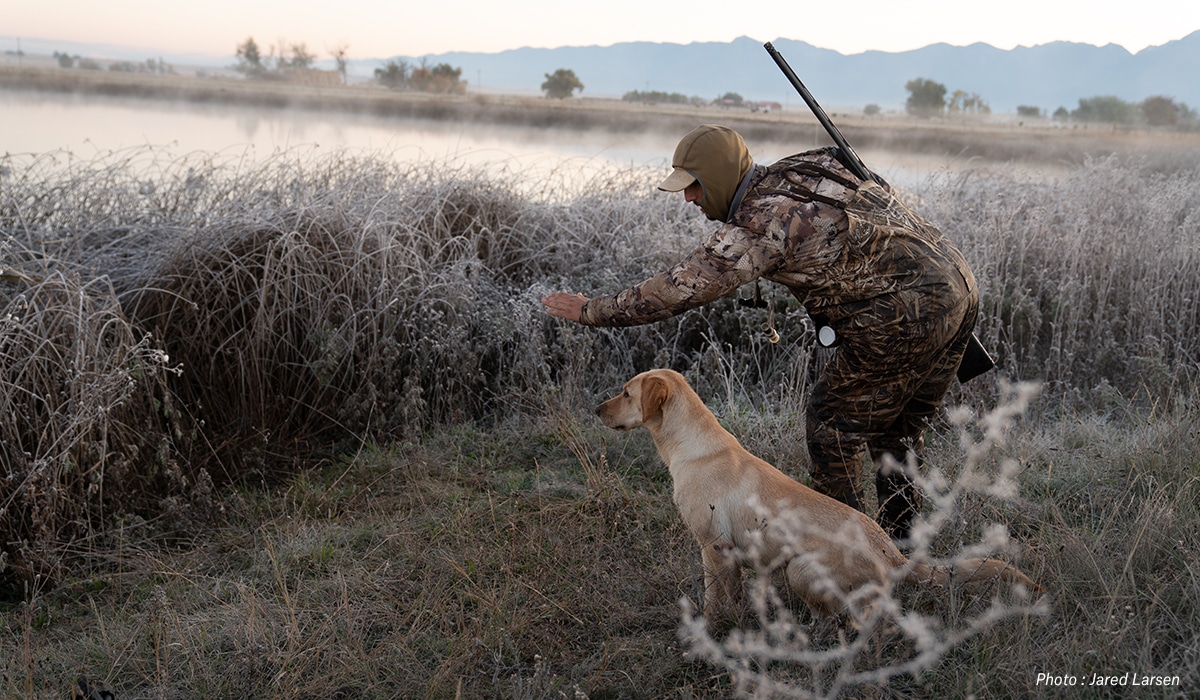
Common Pitfalls and How to Avoid Them
One of the most common mistakes Gibson sees new dog owners make is perhaps one of the more obvious.
“The biggest thing we see is people buy a dog, drop the dog off at training, and then never come back to visit until the dog is ready to go home,” he notes. “They then spend 10 minutes with the trainer and think they have a good grasp on what’s needed to keep the dog working at that level.” Gibson believes training doesn’t simply stop at the dog. “Two things to be trained: the dog and the owner, and the most difficult is the owner. We like the owner to come down as often as they can during the hunting dog training process.”
“Two things to be trained: the dog and the owner, and the most difficult is the owner.”
Fortner sees new dog owners make the mistake of relying on crowd-sourced advice.
“I see two mistakes commonly made by both experienced and inexperienced dog handlers,” he shares. “First, they ask questions of and seek advice from the internet—message boards and, in particular, Facebook. Most of the time, you do not know who you are talking to, or if that person really knows what they are talking about.
“The second mistake is that we unconsciously train our dogs to develop bad habits and bad canine manners. When you go pick up your puppy from the kennel, all the cute little pups are jumping up on the kennel fence clamoring for attention. Who can resist those cute furry faces? We just instinctively reach down and pet the pup. What just happened? The puppy just learned that by jumping up, he will be rewarded by attention from a human. Pups should only be petted or otherwise rewarded when they are sitting calmly or performing some other desired behavior. Don’t unconsciously reward undesired behavior.”
Fortner adds that this unconscious-trained behavior also translates into the duck blind and hunting retriever. When you are playing and informally training your dog in the backyard by tossing bumpers for him to retrieve, most of us will hype up the dog and let him chase and retrieve every bumper. The lesson learned? First, that retrieving is an exciting task. (Maybe in the field trial, but not in the duck blind). The dog has learned that every bumper or duck is his and his alone to go get. This leads to steadiness issues in the pit with the dog breaking at the sound of the gun or ducks falling. The better tactic is to allow the dog to retrieve every second or third bumper thrown, and only after being released or commanded to fetch.
“The behaviors are easy to train in the new pup, but once the undesired behaviors have been ingrained into the dog’s mind, they are hard to unlearn,” he notes. “Dogs are masters at nonverbal communication. They watch you and they pattern you. This means that dog training never stops. It’s not just the 30 minutes you spend with formal training in the backyard, it’s a 24-hour-a-day commitment—the dog is constantly learning and being trained. I tell my guys all the time, ‘Be the human; don’t let bad behaviors develop, and certainly don’t reward them. Control the things that can be controlled. Demand correct behavior and obedience.”
“This means that dog training never stops. It’s not just the 30 minutes you spend with formal training in the backyard, it’s a 24-hour-a-day commitment—the dog is constantly learning and being trained.”
The theme of obedience and steadfastly correct behavior is something that Loeffler focuses on as well.
One of the most frequent questions he gets is about dogs who are eight to 12 weeks old, whose biting starts getting a bit more aggressive and beyond the puppy-play biting.
“One way I deter puppies from biting is when they come to bite, I’ll roll their gum under their tooth to replicate a bite (first time pretty light, and the times later slightly harder),” he notes. “It’s like your dad grabbing by ear and twisting your ear; like a “bite back” to the dog. People try to be too soft on the puppies—you don’t want to be too hard; you want to maintain love and trust, but you can’t let them get away with all the BS they’re going to try. Give ‘em an inch and they’ll take a mile. Get respect from an early age in a very humane way that they understand, like their mom grabbing by their throat and flipping over puppies. Immediately you see a change to a calm, submissive state in the puppy. That’s how you establish dominance over that puppy, how you get that puppy to submit to you. The world is back to being a good place and in control; you’re in control of the current situation, not the puppy.

“The more clearly you can communicate with a puppy, the faster you’ll get from point A (puppy) to point B, which is a finished retriever. It’s all about communication. Communicate as clearly as possible with something that has about the same mentality of a human toddler.”
With proper training, you’ll protect your friend, your investment, and your time.